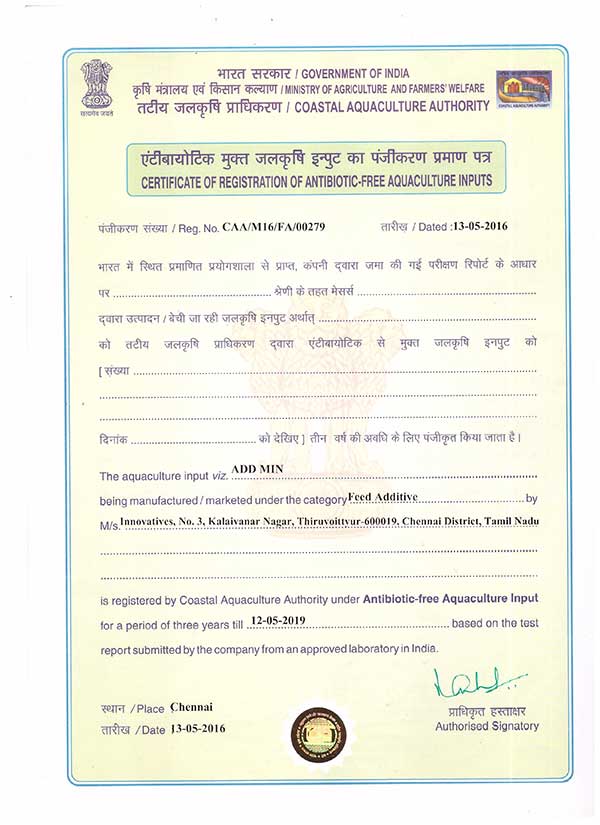ADD MIN
Mineral Mixture Litopenaeus/Whiteleg Vannamei
Salient Features
* Builds critical levels of many trace elements
* Cost effective
* Easy to administer
* Greater microbe activity in the gut
* Helpful in the cases of malabsorption conditions of the g.i. tract
* Increases levels for energy, water and nutrient holding capacity
* Increases the ability of animals to resist pest and disease attack
* Improved animal health reduces input costs through efficiency
* meets the demands of modern animal genotypes with higher requirements
* Most useful in stress conditions
* Promotes availability of both minerals and proteins
* As nutrients to the animal
* Reduces pollution
* Rebuilds tired feed rations through remineralisation
* Species and age specific
INORGANIC MINERALS

LIMITATIONS :
| Element | Species | Toxicity sign |
|---|---|---|
| Zinc | Common carp (C. carpio) | Reduced growth (dietary level above 300 mg/kg Zn; 1) |
| Copper | Channel catfish (I. punctatus) | Reduced growth, feed efficiency and haematocrit (dietary level above 15 mg/kg;2) |
| Selenium | Rainbow trout (S. gairdneri) | Reduced growth and feed efficiency, high mortality (dietary levels above 13 mg/kg; 3,4); nephrocalcinosis (4,5) |
| Channel catfish (I. punctatus) | Reduced growth (dietary levels above 15 mg/kg; 6) | |
| Cadmium |
Rainbow trout (S. gairdneri)
Common carp (C. carpio) |
Scoliosis, hyperactivity (7–10) |
| Lead | Rainbow trout (S. gairdneri) | Scoliosis, lordosis, black tail, anaemia, degeneration of caudal fin (11) |
| Chromium | Rainbow trout (S. gairdneri) | Reduced growth and feed efficiency (12) |
| Iron | Penaeids (P. japonicus) | Reduced growth (dietary levels above 0.014%; 13) |

MINERAL INTERACTIONS:
O’Dell (1997) defines mineral interactions as ‘’interrelationships among mineral elements as revealed by physiological or biochemical responses’’. O’Dell (1997) divided interactions into two major classes, positive (commonly synergistic) and negative (antagonistic). A high concentration of an antagonist element decreases the biologic effectiveness of its target element. Antagonistic interactions are often expressed as a mutual inhibition of absorption from the intestinal tract but can also occur at the cellular level (Henry and Miles, 2000). Interactions can occur between two minerals (e.g. calcium and phosphorus), or multiple minerals (e.g. copper, molybdenum, and sulfur). The current presentation will be limited to a discussion of mineral interactions that can have practical implications for ruminant animals.
ADD MIN COMPATABILITY
Examples of formulation additives that can be admixed or co-administered with ADD MIN include Starches, Protein Concentrates, Probiotics, Yeast, Organic acids, free Amino acids, Amino acid salts, Toxin Binders, Antibiotics, Liver Stimulants, Fillers, Flow control agents, Lubricants, Flow agents, Hydroscopic minimizing agents, pH control agents, Catalysts, Vitamins, Coenzymes, Cofactors, Herbs or herbal extracts, Protein powders, Dust control agents, Binders, Disintegrating agents, Flavoring agents, Taste-reducing agents, shellacs, waxes, emulsifiers, oils, combinations thereof, and other known additives.
Minerals are inorganic as they exist naturally in the soil and water. Minerals are organic as they exist in plants , animals and all living things. Only plants can transform inorganic Minerals to organic minerals. Animals must consume plants or plant eating animals to obtain their organic minerals. Direct consumption of inorganic Minerals are useless and injurious to the animal organism.
FDA has issued an alert to the feed industry warning against the use of mineral mixes and pre mixes that are by products or co products of industrial metal production.( F.D.A. CUM update,2003)
Although there was a nutritive similarity between chelated proteinated ,nano,colloidal,organic and inorganic materials, each of these will have different impact on the performance. Chemically it is true that iron in the blood stream and iron in nails are the same and calcium in rocks is identical to calcium in the bones. However,it is a grave mistake to believe that the shrimp can digest and assimilate and utilize powdered nails and crushed rocks.
Inorganic minerals can't assimilate by shrimps. Intact,the shrimp's organs must work harder to compensate for the imbalance created by ingestion of these supplements. The shrimp accelerates its elimination activities and works hard to expel these foreign substances. Shrimp hepato pancreas do it and easily get damaged that lead to Running Mortality Syndrome.

Trace Minerals for Litopenaeus Vannamei
| Cobalt | 0.0038 |
| Copper | 0.069 |
| Iron | 6.2 |
| Iodine | 0.012 |
| Manganese | 0.32 |
| Selenium | 0.004 |
| Zinc | 2.38 |
| Aminoacids | 40 |
Application:
1 L /Acre once in 15 days in pond water medium and 0.5 L per 1 MT feed in alternate days

Copyright © 2025 InnovativeS. All Rights Reserved ishrimp.in